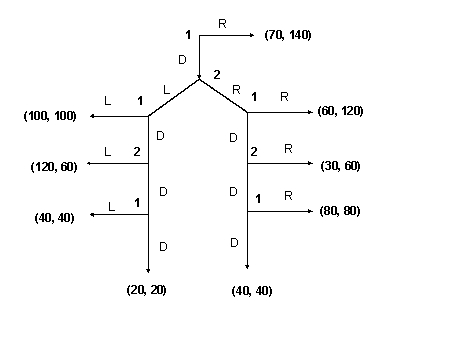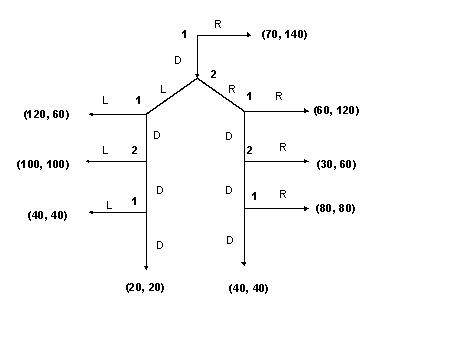Not Answered
Consider the following two two-player games - Game 1 and Game 2. In each game, 1 and 2 refer to the two players. The first number in each payoff box refers to the payoff for player 1 and the second number to the payoff for player 2. The strategies L, R, and D stand for Left, Right and Down respectively. At each node I have shown the player who gets to move at that node.
Game 1:
 Game 2:
Game 2:
 (a) What is the subgame perfect equilibrium in Game 1 and Game 2? (It is the same in both games. So you only need to solve for it once.) (b) In which game - 1 or 2 - is the symmetric joint payoff maximizing outcome of (100, 100) more likely? Is it Game 1 or Game 2? Why? Explain briefly.
(a) What is the subgame perfect equilibrium in Game 1 and Game 2? (It is the same in both games. So you only need to solve for it once.) (b) In which game - 1 or 2 - is the symmetric joint payoff maximizing outcome of (100, 100) more likely? Is it Game 1 or Game 2? Why? Explain briefly.
Correct Answer:

Verified
Correct Answer:
Verified
Q26: In the Berg et al. trust game,
Q27: The study by Snijders and Keren suggests
Q28: Two key components of the loan system
Q29: With regards to the trust game, the
Q30: Which of the following is not a
Q32: Denote the amount sent by the Sender
Q33: "Extrinsic" motivation:<br>A) explains why we often do
Q34: According to research undertaken by Truman Bewley
Q35: In the Berg et al. trust game,
Q36: In the trust game, where amounts send